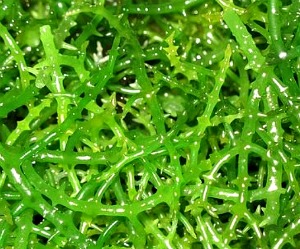 Seaweed is a plant that grows in the sea. There are thousands of different kinds of seaweed all over the world. Like plants that are grown on land, some seaweeds are also farmed to give you both food and money.
Seaweed is a plant that grows in the sea. There are thousands of different kinds of seaweed all over the world. Like plants that are grown on land, some seaweeds are also farmed to give you both food and money.
One seaweed species is particularly well known, the Eucheuma. It has been farmed now for several years by coastal villagers. Some of them have been successful and are cultivating seaweed as their main source of income. Eucheuma seaweed can grow in different colors. You can find some plant to be either green or brown. Despite their different colors, these plants give the same end-product.
Eucheuma seaweed has no roots but some of its branches can attach to corals and grow. Even though seaweed grows in all directions, most of its branches grow up toward the sea surface. The branches can grow in many different forms depending where the seaweed is planted. Do not be surprised to see your seaweed looking different during the year.
In the warmer months, seaweed might grow thick with a few branches only, whereas in the cooler months, you might see plenty of shoots growing. This is because of the lower sea water temperature during winter, together with a moderate water movement and increased amount of plant food in the water.
How to grow Eucheuma Seaweed
Seaweed grows better and faster during the winter season, but it can be successfully grown all year around. Just to give an idea of how fast seaweed grows, imagine that the weight of your seaweed can become 10 times heavier in 6 to 8 weeks. In other words, if you have a 150 gram plant to start, after 6 to 8 weeks that plant will weigh about 1.5 kilograms. Thus, Eucheuma seaweed has a very fast growth; a clear advantage for the farmers!
How does Eucheuma seaweed reproduce?
In the seas where seaweed grows naturally, waves and strong currents occasionally break seaweed branches. These branches, drift away and eventually settle between corals or on sandy sea bottoms. Here, they anchor and start to grow again. A new seaweed patch has been formed. In this way seaweed has spread to many parts of the world.
Because of the way this seaweed reproduces, it is easy for the farmer to cultivate it. The only thing you have to do to grow your seaweed, is to cut the young branches, and re-plant them.
What will be the benefit of farming seaweed for my village?
Farming seaweed is a new job opportunity for you and your fellow villagers. It will bring money and give you the possibility to improve your standard of living. At the same time, farming seaweed will not stop you from performing other activities such as fishing or cutting copra. You still have plenty of time for those.
If you compare seaweed farming with other activities, you will find out that seaweed can assure you a continuous and constant earning all year around. What other jobs can give you this?
Your wife and the other women of your village will be also benefiting from farming seaweed, in fact for them, working in a seaweed farm will be a rare chance to earn money. Your kids can also participate by helping you prepare the lines, cut raffia strings, tie seaweed seeds, etc. All easy jobs. In other words you will be able to work with your family and enjoy your work.
Seaweed farming is not harmful to the environment. Different kinds of fishing have already caused serious damage to the sea. Remember when beche-de-mer were everywhere? Today it seems difficult to find a place with plenty of them. The same happened for a lot of marine species. Seaweed farming will not take away anything from the sea. You are just cultivating it. In fact, places where seaweed is farmed, become a sheltered area for other valuable marine organisms such as beche-de-mer, cockles, sea snails, small fish and many others. So your farming activity will be of benefit to the sea as well.
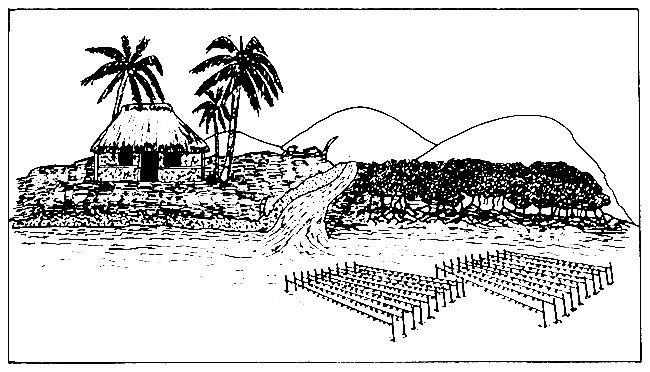
How seaweed is used by food and other industries?
Through industrial processing of the seaweed you cultivate, many edible and non-edible items can be made.
The most important component of seaweed, in terms of industrial use, is a substance called carrageenan also commonly known as seaweed flour.
From your dried seaweed, about 25% of the weight is carrageenan. This can be extracted through a complicated industrial process.
Carrageenan, in its semi-refined or refined form, is used to manufacture food items, both for human and animal consumption.
To give you an idea of what can be done with carrageenan, this substance is used in the manufacture of ice cream, chocolates, custards, cake topping and fillings, milk shakes, yogurts, dessert gel, canned foods, fish gel, sauces, and many others. As you can see, it has a large number of applications for a sole chemical substance. But that is not all!
Carrageenan is also used in the manufacture of water based paints, toothpastes, lotions, shampoos, and beer. You will also find carrageenan to be an essential component in several pharmaceutical products as well.
In some overseas countries, such as Indonesia and Philippines, Eucheuma seaweed is also eaten raw. People like to eat it fresh in salads.
GROWING SEAWEED
Locating a suitable site is the key to success in cultivating Eucheuma seaweed. Numerous factors influence the growth of Eucheuma and should be considered while choosing a farming area. These are listed below.
Water Temperature
A water temperature ranging form 25 °C to 30 °C is best for growing Eucheuma. In shallow waters near the beach, the water temperature can become quite high especially during a sunny day. Such an area is not suitable for planting seaweed. In fact, even though you might think that the shallow sandy bottom is good for securing your stakes, the high water temperature will kill your plants.
So, we suggest that you set your farm away from the lowest tide mark (spring low tide limit). A good area is the one between the spring low tide limit and the reef edge or an area which does not dry up during these big low tides occurring during full or new moon.
Water Salinity
Minimum water salinity required is about 28 ppt (parts per thousand) or more. Salinity is the term used to indicate the amount of salt you can measure in sea water. Do not worry! By tasting a few drops of salt water in your mouth, you can feel the difference in salinity. Brackish water at the river mouth will taste less salty than ocean flowing water. Be sure that you do not plant your seaweed in front of a river mouth or in fresh water, as fresh water will kill the seaweed.
Bottom Type
A white sandy bottom with the presence of a limited amount of natural seaweed, is probably the best place to cultivate Eucheuma. If the bottom is covered with seagrass, Eucheuma will not grow very well. This is because other seaweeds might compete, absorbing the nutrients from the water leaving your Eucheuma plants starving. In this situation, your plants might be covered with unwanted seaweeds and as a result, silt will quickly deposit on them.
A sea bottom with hard coral formations and coral heads is not a good site to establish your farm. In such areas it is difficult to secure your stakes. In addition, plant eating fish generally live and aggregate around coral heads. From here, they move out from time to time to graze on your seaweed. As a result, they damage your plants.
A muddy sea bottom, is also not advisable for your farming site because silt or mud will cover the plants reducing the seaweed growth and some extra work will be necessary to shake and keep clean your plants. Also murky water will limit the amount of sunlight that is supposed to reach your plants.
Now you can see why we suggest you choose a nice white sandy bottom to set your farm.
Water Movement
Moderate water movement is mostly preferred to strong water current like the one you can see close to the reef edges or in its passages. If the water current is too strong, it can damage your plants and even wash away your planted lines by pulling down the stakes. It will also slow down your work as it is difficult work in areas with strong swift current.
However, be sure that there is a constant exchange of ocean water as the one you have with the changing of the tides and sufficient water movement as the one created by waves. This will bring the necessary nutrients to the plants for a healthy growth.
As for any type of farming, the supply of nutrients is an essential factor for growing your crops. This applies to seaweed cultivation too. Therefore, remember to consider water movement as an important factor for seaweed growth while selecting the area for your farm.
You must be sure that the farm is placed in such a direction that the water current flows into the farm and not against it/
Sunlight
Eucheuma requires sufficient sunlight for growth. Sunlight is used by Eucheuma as a source of energy for its growth and to manufacture carbohydrates like carrageenan, the commercially valuable substance inside the seaweed. Thus, it is essential to have plenty of sunlight. Clear seawater allows sunlight to penetrate more easily to the plants. This is why when seaweed is planted close to the sea surface, it grows faster and healthier compared to that planted close to the sea bottom or in deep water.
Water Depth
At least knee deep water at spring low tide (0.5 meter) is the minimum water depth required to cultivate Eucheuma. In shallower waters seaweed can still grow, but it might be exposed to direct sunlight and wind. As soon as your seaweed is exposed to sun and wind, the tender tips of the plants are destroyed and if exposed for a long time (2 to 3 hours), the whitening of the branches can be seen. This will indicate that part of the seaweed has been killed. Eventually branches will break and drift away from the whitened area.
So, it is important to consider the water depth while selecting the area of cultivation.
Water Pollution
Because Eucheuma prefers clear water and plenty of sunlight, even turbid water (muddy) will not sustain good seaweed growth.
Chemical pollution will kill the seaweed as in the case of most marine plants and animals.
We suggest, after you select one location you think is good to grow Eucheuma, to plant several lines of seaweed in various spots within that area and observe its growth. This will be the best way to find out the ideal area for farming.
Three (3) methods use to cultivate seaweed:
1. Off-bottom (fixed bottom) Method – Wooden stakes are driven into the sea bottom 20 to 25 centimeters apart form each other in straight rows. The stakes should be 5 to 10 centimeter in diameter and 1 or 1.5 meter long. At least 0.5 meter of the stake should be driven into the sand to make them secure.
A 3 millimeter thick polypropylene rope 5 meters long is firmly stretched between two stakes. Attached to the 3 millimeter rope (line) are 30 pieces of raffia (polypropylene strings). Each of your planting material (seed), the size of the palm of your hand (150 grams), is tied to the raffia strings. The 3 millimeter rope, is suspended at least 20 to 30 centimeters from the sea bottom to prevent the growing seaweed from being tossed on the sand and 20 to 30 centimeters below the water surface at low tide to avoid the seaweeds from being exposed to direct sun light. Direct sun light will kill the exposed parts.
Stakes must be sharpened at one end so that they can be easily driven in the sand. You can use mangrove stakes or any other bush timber which does not rot easily in sea water.
The raffia strings, should be 20 centimeter in length with both ends knotted to prevent fraying as shown in the previous photo. The raffia strings are firmly tied to a 3 millimeter rope in such a way that it will not move along the rope as the seaweed grows bigger, or during rough weather.
If you are preparing your lines with seed on the shore, make sure the seaweed is covered and, when possible, prepare your lines at night or in the shade during the day. Your seed will remain alive out of the water, if you keep it moist.
Try your best to prepare the lines as quickly as possible and place them in sea water. Remember, the seaweed seed will grow better if you limit the time the seaweed is kept out of the water.
Also, remember that you need to tie the raffia strings to your lines on shore before you tie your seaweed seeds to them.
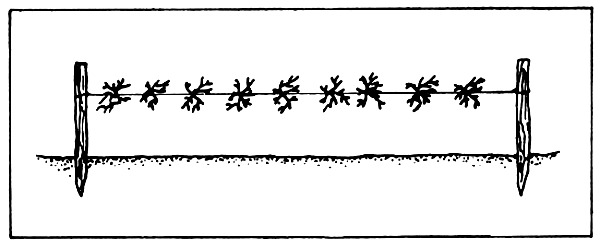
2. Raft or Floating Method – In the floating method, seaweed is attached to some device that keeps the seaweed floating; rising and falling, with the tidal changes.
Following this method, be sure to keep the seaweed about 50 centimeters below the water surface.
The floating devise can be a simple frame made of bamboos, mangrove wood, or bush timber durable in seawater. You can tie together four 2.5 meter long bamboos into a square frame and stretch 3 millimeter ropes (lines) inside the frame.
In a 2.5 meter square frame, you can stretch up to 15 lines, 10 to 15 centimeter apart. Each line will carry 15 pieces of seaweed tied to the 3 millimeter rope with raffia.
In a frame like the one described, you can plant up to 225 pieces of seaweed.
In this method you can tie your seaweed on shore by placing the raft on a support (oil drums or wooden posts). In this way it will be easy for you to tie your seeds to the lines.
The square floating frame, should be anchored to the sea bottom as shown in the figure. As the seaweed starts to grow and become heavier, the frame will sink. To avoid this, be sure to attach to the frame extra bamboos or floaters. Floaters can be simply made of Styrofoam or bags filled with unhusked coconuts.
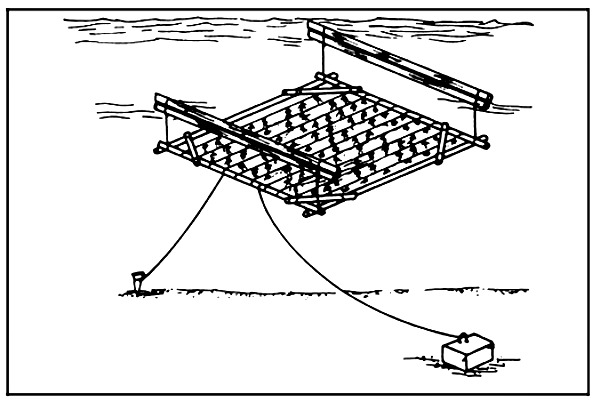
3. Longline Method – The longline method is similar to the raft or floating method in several ways. In fact, seaweed is hung to a rope which is suspended by floaters. In this method, however, the main rope is thicker; about 10 to 15 millimeters in diameter. This rope is tied to plastic floaters or bamboo set at 4 to 5 meters interval and anchored at each end. The pieces of raffia holding the seaweed, can be tied to the main rope in two ways.
Simplest way. The raffia string are directly tied to the main rope.
Additional pieces of rope, 0.5 to 1 meter long, can be tied to the main line and the raffia strings can be tied to them.
Remember that your seaweed has to be hung near the water surface to receive sufficient sunlight. You can suspend the main line about 0.5 meter below the water surface.
As described in the first two methods, the lines can be prepared on shore. Generally, in the long line method, if you prepare your lines on shore, it will be difficult to stretch them since they are heavy and may tangle easily. If so, you might loose some seaweed seeds. We suggested, that you tie your seaweed seeds to the main line once the line is already stretched and suspended with floaters. You should prepare the lines from your punt.
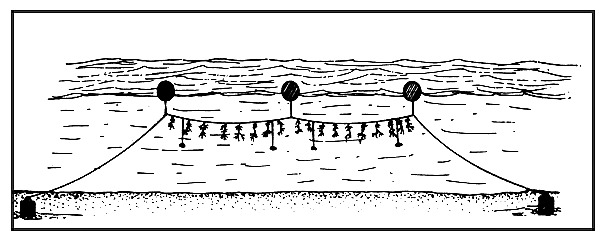
How should I handle my seaweed?
When you need to transport your seaweed seeds from one place to another, as in the case of taking your seeds to another village or even when you want to take seaweed at home to prepare your lines, you should consider that the seaweed is a living plant and needs particular care.
The first thing you should do, is to cover your seaweed with tarpaulin or coconut leaves. If you know that you will be travelling for several hours moving your seaweed, it is advised to put it in jute or onion bags. It is very important to keep the seaweed moist at all times. You can pour sea water over the bags or, when you have a chance, dip the bags in the sea.
You can also use Styrofoam boxes to transport your seaweed. In this case, make a few holes on the upper edges of the box to facilitate aeration. Remember to keep the seaweed moist. Do not fill the box with seawater as this will make the seaweed rot rapidly unless the sea water is constantly circulated
What can harm my seaweed ?
You should keep in mind that there are several factors that can damage your farm. These might occur especially during the warmer months of the year, from December to April. During these months, seaweed is more susceptible to diseases and is readily harmed by grazers. Also during this period, the growth of Eucheuma slows down and cyclones and bad weather may cause some damage to your farm. Drying in this period can also be difficult.
Natural predators
As frequently observed, rabbit and puffer fish are the main seaweed grazers. In addition to these, sea urchins and sea turtles are also often seen damaging the seaweed plants. Among all of these, rabbit fishes are usually the most destructive.
During the warmer months, large schools of rabbit fish 1 to 6 centimeters in length, can be seen living among your seaweed lines. On some occasions, these small rabbit fish have grazed seaweed to such an extent that they have entirely destroyed seaweed farms.
After the warmer months, the rabbit fish grazing becomes a minor problem. In fact, rabbit fish move away from the seaweed. It is always a good idea to set your farm far away from coral heads, since these fishes normally live around the corals and move out to graze on seaweed.
Do not leave rubbish (tins, unused stakes, bits of wood, etc.) as these make a very good home for rabbit fish.
Diseases
Even though there are no specific diseases that might affect Eucheuma, in situations where plants are heavily grazed it is common to observe whitened areas on their branches.
Whitened areas are more exposed to fungal infection. Especially during the warmer months, fungal infection can spread quite rapidly and the seaweed plants show large portions of discolored branches commonly seen as white and pink areas. “Ice Ice” is the common term used to describe seaweed plants in this condition.
Weather
Apart from occasional bad weather (rough sea and heavy rain), the effect of cyclones occurring during the summer months can be devastating. Cyclones cannot be avoided, but what you can do is take precautions.
During the cyclone season, you should listen to the radio weather forecast regularly and carefully. If a cyclone is expected, harvest as much seaweed as you can and keep it on shore protected from wind and rain.
Put aside sufficient seaweed to allow you to re-start farming after the cyclone has passed by. Remember you need to keep this seaweed in bags moist with seawater at all times. That seaweed will be your re-planting material.
If seaweed is kept small during this period, and not allowed to become over-mature, little damage is expected. You might decide to harvest after 4 or 5 weeks of growth instead of waiting for 6 or 8 weeks. Experience after going through several cyclones suggest that this strategy could limit your damage.
Also, be sure that your stakes are firmly erected otherwise the strong water currents and swells during cyclones might wash away your effort.
After the cyclone has gone through, tangled lines should be entangled and secured again. Badly damaged seaweed should be completely removed and replaced with new seeds.
If you are heavily hit by a cyclone but you have not lost all your seaweed, then it is possible to be back in full business again after 8 weeks. A lot of work has to be done and done quickly, but it will worth it.
How much will it cost to start seaweed farming?
The amount of money necessary to start up a seaweed farm, depends on the size you have in mind. We suggest you start your farming activity with a small set-up. Just 320 or 480 lines. After some practice, it will be up to you to decide whether or not to expand your business. To give you a better idea of what you need to start your farm, in the following Tables 1 and 2, are listed the materials necessary to start a 320 and a 480 line seaweed farm and their costs. Some materials such as wooden posts or stakes, can be available to you at no cost if you decide to utilize mangrove or other bush timber, and obtain these yourself.
What should I do to maintain my farm?
To be a productive farmer, the seaweed farm should be well attended. This means that you constantly visit and check your farm.
Seaweed needs to be kept clean. To do this, you can shake or raise the seaweed lines to remove any unwanted seaweeds and rubbish.
If you do not keep your seaweed clean, other seaweeds will take away the nutrients necessary for your plants growth. As a result your plants will not grow very well.
To assure a better growth, it is advisable to remove silt or mud coating on the surface of the seaweed, by shaking the lines. The parts of the plants showing white and pink areas, should be removed and taken to the shore.
Detached lines should be fastened and lost plants replaced.
Slow growing strains should be harvested and replaced with fast growing strains.
Fish grazers, especially the bottom and coral dwelling species, should be kept away or fished if possible.
Seaweed should be harvested as soon as it reaches its harvesting size (6 to 8 weeks), and re-planted immediately for a continuous harvesting and re-planting cycle. Do not leave your plants to over-grow as they will break and easily drift away. Over matured plants are difficult to dry as their branches are thicker.
How much I will earn from my seaweed farm?
This is probably the point in which you are interested the most. How much you can earn.
Larger farms will earn you a higher income, but will also require more effort, commitment and initial investment. You will also need more people to help you maintain the farm, unless your wife and your kids work with you.
HARVESTING AND SELLING SEAWEED
Seaweed is harvested on a weekly basis after 6 or 8 weeks of growth depending on the culture method you use.
It is the responsibility of the seaweed farmer to harvest the crop, dry the harvested seaweed and keep it in a well protected place such as a storage shed until the buyer comes to the village to collect it.
Harvesting Seaweed
Harvesting is a simple work to perform. It involves:
- removing of the mature seaweed plants from the lines by unfastening the raffia knots, or by breaking off the plants;
- spreading the seaweed plants over a drying rack; and then
- removing raffia and other unwanted materials.
Drying Seaweed
The drying rack should be built in such a way, keeping in mind that air should easily circulate through the seaweed to assure good ventilation and quick drying.
The simplest way to dry seaweed is by spreading the harvested wet seaweed over a net, a tarpaulin or over coconut leaves on the ground. However, in this way only the seaweed exposed directly to the sun (top portion) will dry efficiently and the remaining (lower portion) will stay wet.
Air ventilation is very limited when seaweed is dried on the ground.
If you find it convenient and handy to dry the seaweed on the ground, be sure that the seaweed is at least partially dried. Fresh wet seaweed, just harvested, cannot be placed directly on tarpaulin for proper drying.
Moreover, if you dry the seaweed on the ground, sand, soil and other rubbish can mix with the wet seaweed. The seaweed buyers will not buy a dirty product.
The best way to dry seaweed, is to use a drying rack with the drying area made of sarlon netting. The rack can be constructed on shore or near your farm.
In some cases it might be difficult to find the netting which can also be expensive. You can use reeds or bamboo instead.
Just to give you an idea, consider that in an area of 100 square meters (20 meter by 5 meter) of sarlon netting, you can dry approximately 80 lines of mature seaweed at one time or more.
With plenty of sunshine, let’s say 8 to 9 hours a day, the drying process will take you 3 to 5 days. Seaweed should be frequently tedded or turned for proper and quick drying. Also, for efficient drying, make sure the seaweed is thinly and evenly spread.
If you weigh your seaweed before and after drying, you will find out that the original weight has decreased by approximately 10 times. So, if you had 10 kg of wet seaweed, after 3 to 5 days of sun drying, it will weigh only 1 kg. This is called 10 to 1 wet to dry ratio.
The minimum moisture content which is required by the seaweed buyers, is about 35 %. Don’t worry! You do not need to measure the moisture content of your seaweed before selling it. Just make sure that seaweed is properly dried as suggested.
Well dried seaweed is covered with plenty of salt crystals and have rubber-like texture when you squeeze it and no water should drip from it.
It is wise to cover the drying seaweed during rainy weather or at night with a tarpaulin or anything that can prevent the seaweed from getting wet. You might have unexpected showers at night! If seaweed is rain-washed, it will take more time to dry and you will face a further weight loss. This is a disadvantage for the seaweed farmer as the moisture content will be lower and the seaweed will become partially rigid. Very difficult to pack.
Rain-washed seaweed will give you less money than you might expect.
Storage of Dried Seaweed
After drying and before packing the seaweed, be sure to remove any rubbish material (raffia, pieces of nylon ropes, plastics, other unwanted seaweeds, etc.). The people that come to your village to buy seaweed, will appreciate a clean and well dried product.
Well dried seaweed with salt crystals on its surface can be stored for a long time; up to 2 years without getting spoiled. The salt covering the seaweed prevents the spoilage of the carrageenan. Of course it is important that seaweed is stored properly.
It is always a good idea to pack your seaweed in polypropylene bags soon after drying and store it in a dry area. Polypropylene bags are the best because they do not soak up water as compared with jute bags.
In some cases you can store the packed seaweed in your house, if there is enough space. You can also build a storage shed in the village.
It is the responsibility of the buyer to bale the seaweed and move the bales to the collection centers for consolidation and loading of the containers. He will also take care of transporting the container to the closest harbor with access to international routes for export. He will take charge of dealing with the overseas buyer.
Sources and Photos: www.fao.org